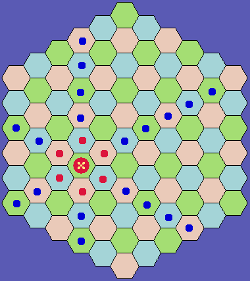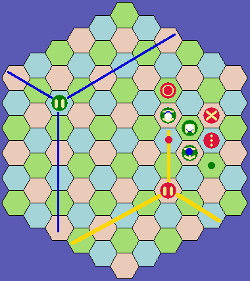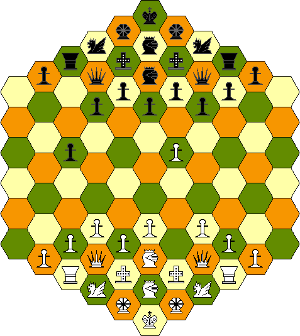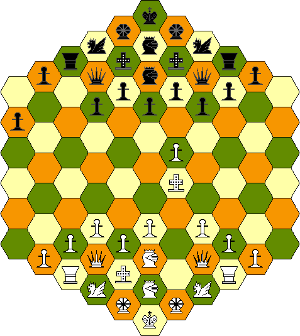Quantimex
This variant arose from an interest in Quantum Mechanics and my
wondering
if a quantum chess was possible. Â This attempt starts from the
variant Ultima, uses a hex board and attempts to adopt the Heisenberg
uncertainty principle and to a much lesser extent particle entanglement.
Setup
The board consists of 91 hexes, and each player begins the game with 22 pieces; a piece-density of  48%.
Pieces
| Name |
Icon |
Number | Descriptiom |
|
| King |
  |
1 | Moves a single step into one of
the 6 adjacent hexes.  Captures by replacement. May move to a hex occupied  by a Regent.  This is called "enthronement".  The enthroned Regent is removed from play.  The King may make this move even if frozen by an Immobilizer. |
|
| Regent |
  |
2 | May
move up to 6 steps in a straight line. Â Cannot capture when
moving
more than a single step. Â Â Cannot leap other pieces
whether
friend or foe. May move a single step like the King. Â When moving a single step may capture by replacement. The Regent in the image to the right can reach any hex marked with a red or blue dot. Â It can capture enemy pieces in the hexes marked with a red dot. |
 |
| Mimic |
  |
2 | Called
a Chameleon in Ultima. Â May move up to 6 steps in a straight
line.
 Cannot leap other pieces whether friend or foe, except for
enemy
Long-Leapers which are then captured. Captures by using the method of capture of the piece being captured. Â Immobilizes an Immobilizer. Can only capture Pincer-Pawns if moving in one of three three Pincer-Pawn directions. |
|
| Long-Leaper |
  |
2 | May
move up to 6 steps in a straight line. Â May leap over enemy
pieces
provided the hex immediately beyond the piece is empty. Â Such
enemy pieces are captured. Cannot leap over friendly pieces. |
|
| Coordinator |
  |
2 | Â May move
up to 6 steps in a straight line. Â Cannot leap other pieces
whether friend or foe. Captures by coordinating with its King or a friendly Regent.  This coordination capture is illustrated by the image to the right.  Assuming the red Coordinator has just moved and is on its final destination hex, then the hexes marked with a yellow dot  are where enemy pieces would be captured. |
 |
| Withdrawer |
  |
2 | Â May
move up to 6 steps in a straight line. Â Cannot leap other
pieces whether friend or foe. Captures any adjacent piece by moving directly away from it. |
|
| Immobilizer |
  |
2 | Â May
move up to 6 steps in a straight line. Â Cannot leap other
pieces whether friend or foe. Does not capture, but "freezes" any adjacent enemy piece. |
|
| Pincer-Pawn |
  |
9 | Â May
move up to 6 steps in a straight line. Â Cannot leap other
pieces
whether friend or foe. Â Unlike the other pieces that may move
in
any of six directions, the Pincer-Pawn may only move in one of three
directions.  These are one "directly forward" and two
"obliquely back". Â See the image to the right where the
diections of movement are shown  with yellow lines for the red
piece and blue lines for the green. Captures by trapping an enemy piece between itself and another friendly piece. Â When capturing, the moved Pincer-Pawn, the enemy piece to be captured, and the other friendly piece involved, must all be in a straight line. Â Thus when moving to the hex marked by the red dot, the green pieces marked by a white dot are captured, while that marked by a blue dot is not. Â To be captured there would need to be a red piece in the hex marked by a green dot. |
 |
Rules
1.  Starting array, pieces and movement.      There are two sides, Red and Green.  Each player takes it in turn to move one of their pieces.  Red moves first.
      For piece types, their initial placement, and their movement, see above.
2. Uncertainty.
      When a piece moves more than one step its final destination hex becomes uncertain, and is determined by the opposing player subject to the following conditions -
 A
piece has been moved by its owner to the central blue hex along the
path of the white line.
A
piece has been moved by its owner to the central blue hex along the
path of the white line.If the piece has moved:
    just a single step then the final destination is the central blue hex, there is no uncertainty;
   2 steps then the final destination may be the central blue hex or the hex marked with a white dot;
   3 steps then the final destination may be the central blue hex or the hexes marked with a red dot;
   4 steps then the final destination may be the central blue hex or the hexes marked with a white or red dot;
   5 steps then the final destination may be the central blue hex or the hexes marked with a red or blue dot;
   6 steps then the final destination may be the central blue hex or the hexes marked with a red, white or blue dot.
The hex chosen as the final destination must be empty.
   Â
3. Removing a frozen piece
      Any immobilized piece except a King, may be removed from play.  So removing such a piece constitutes a side's turn.  No other piece may be moved.
4. Winning
      To win, capture the enemy king or stalemate your opponent.
  Â
Notes
- The pieces and their names have been taken from Ultima, except for the Chameleon which I have renamed to Mimic as I like to have names with unique initial letters if possible. Â I have also introduced the "Regent" piece, partly to enhance the power of the Coordinator, and partly to help represent Quantum entanglement through the King's enthronement move (an extended form of castling).
- The Heisenberg uncertainty principle states that certain pairs of physical properties, like position and momentum, cannot simultaneously be known to arbitrary precision. That is the more you know about the velocity of a particle, the less you can know about its instantaneous position. Â I have adopted this into this variant as "the further a piece travels, the less certain is its final destination."
| White wins in 3, with a little help from Black |
 White advances a
Pawn, thereby freeing a path for the Coordinator. White advances a
Pawn, thereby freeing a path for the Coordinator.Black is content to leave the moved Pawn in the cell chosen by White. |
 Black
also advances
a Pawn freeing a path for an Immoblizer and a Withdrawer. Black
also advances
a Pawn freeing a path for an Immoblizer and a Withdrawer. White also leaves the moved Pawn in the cell chosen by the opponent. |
 White
now advances the Coordinator freed by the initial Pawn move. White
now advances the Coordinator freed by the initial Pawn move.
Again, Black makes no use of the Uncertainty rule. |
 Black
retreats the Pawn moved last time to the edge of the board. Black
retreats the Pawn moved last time to the edge of the board.
This move removes any uncertainty about White's next move, since all alternative destinations will be blocked |
 White
moves the Coordinator a second time and thus captures the Black King. White
moves the Coordinator a second time and thus captures the Black King.
Despite moving the maximum distance there is no uncertainty about the final destination as all alternatives are either occupied or non-existant. White wins. |
 This 'user submitted' page is a collaboration between the posting user and the Chess Variant Pages. Registered contributors to the Chess Variant Pages have the ability to post their own works, subject to review and editing by the Chess Variant Pages Editorial Staff.
This 'user submitted' page is a collaboration between the posting user and the Chess Variant Pages. Registered contributors to the Chess Variant Pages have the ability to post their own works, subject to review and editing by the Chess Variant Pages Editorial Staff.
By Graeme C Neatham.
Web page created: 2010-08-21. Web page last updated: 2010-08-27
